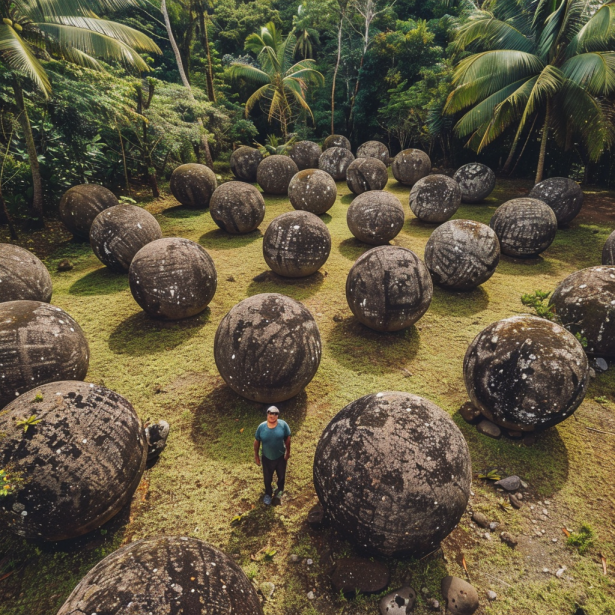Introduction
Scattered across the Diquís Delta in Costa Rica are hundreds of perfectly spherical stones, known as the Stone Spheres of Costa Rica. Discovered in the 1930s during agricultural work, these spheres range in size from a few centimeters to over two meters in diameter and weigh up to 16 tons. Despite extensive research, their purpose and the methods used to create them remain a mystery. The spheres are believed to have been crafted by the ancient Diquís culture between 600 and 1000 CE, but their exact function—whether for astronomical, ceremonial, or territorial purposes—continues to puzzle archaeologists.
Discovery and Description
Initial Discovery
The Stone Spheres of Costa Rica were first discovered in the 1930s by workers clearing jungle land for banana plantations owned by the United Fruit Company. They found numerous stone spheres, some of which were damaged by dynamite used to clear the land.
Physical Characteristics
- Size and Weight: The spheres vary in size, with diameters ranging from a few centimeters to over two meters. The largest spheres weigh up to 16 tons.
- Material: Most spheres are made from gabbro, a type of igneous rock, though some are crafted from limestone and sandstone.
- Precision: The spheres are noted for their almost perfect roundness, an impressive feat considering the tools available to the ancient Diquís people.
Cultural and Historical Context
The Diquís Culture
The Diquís culture, which flourished between 600 and 1000 CE, is credited with the creation of the stone spheres. This culture was known for its advanced metalworking and pottery, but little is known about their stone-carving techniques.
Possible Purposes
- Astronomical Markers: Some researchers suggest the spheres were used as astronomical markers, aligning with celestial events or seasonal changes.
- Ceremonial Uses: The spheres may have held religious or ceremonial significance, possibly representing deities or cosmological concepts.
- Territorial Markers: Another theory posits that the spheres were used to mark territory or denote the power and influence of the Diquís chiefs.
Methods of Construction
Tools and Techniques
The exact methods used to create the spheres are unknown, but it is believed that the Diquís people used a combination of pecking, grinding, and hammering with stones. The precision achieved suggests a high level of skill and significant effort invested in their creation.
Transport and Placement
How the spheres were transported and placed remains a topic of debate. Given their weight, it is likely that simple but effective methods such as rolling on logs or using sledges and manpower were employed.
Research and Theories
Archaeological Studies
Since their discovery, numerous archaeological studies have been conducted to understand the spheres’ origins and purpose. Researchers have used tools like GPS and 3D modeling to analyze their placement and alignments.
Theories and Speculations
- Lost Civilization: Some theories suggest the spheres could be evidence of a lost civilization with advanced knowledge.
- Natural Phenomenon: While some have speculated that the spheres could be naturally occurring, their perfect roundness and context within the Diquís culture argue against this.
- Symbolic Meanings: The spheres may symbolize celestial bodies, power, or other cultural significances yet to be fully understood.
Current Status and Preservation
UNESCO World Heritage Site
In 2014, the Pre-Columbian Chiefdom Settlements with Stone Spheres of the Diquís were designated as a UNESCO World Heritage Site, recognizing their cultural and historical significance.
Conservation Efforts
Efforts are ongoing to preserve and protect the spheres from damage and theft. Many spheres have been moved to museums, while others remain in situ under protective measures.
Tourism and Education
The spheres attract significant tourist interest, and educational programs aim to increase awareness of their importance and the need for their preservation.
Conclusion
The Stone Spheres of Costa Rica remain one of the most fascinating and enigmatic archaeological discoveries. Despite extensive research, their exact purpose and the methods used to create them continue to elude scholars. As efforts to study and preserve these ancient artifacts continue, they offer a tantalizing glimpse into the ingenuity and cultural richness of the ancient Diquís people. The mystery of the stone spheres captivates the imagination and invites ongoing exploration and discovery.
FAQs
What are the Stone Spheres of Costa Rica?
The Stone Spheres of Costa Rica are perfectly round stone balls discovered in the Diquís Delta, ranging in size from a few centimeters to over two meters in diameter.
Who created the Stone Spheres?
The spheres are believed to have been created by the ancient Diquís culture, which flourished between 600 and 1000 CE.
What are the possible purposes of the spheres?
Theories include their use as astronomical markers, ceremonial objects, or territorial markers.
How were the Stone Spheres made?
The exact methods are unknown, but it is believed the Diquís people used pecking, grinding, and hammering techniques to achieve their roundness.
What is the significance of the spheres?
The spheres are significant for their cultural, historical, and archaeological value, offering insights into the Diquís culture and prehistoric craftsmanship.
Are the Stone Spheres protected?
Yes, they are protected as part of a UNESCO World Heritage Site, and ongoing conservation efforts aim to preserve them for future generations.

